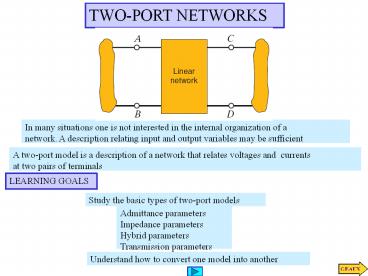TWO-PORT%20NETWORKS - PowerPoint PPT Presentation
Title:
TWO-PORT%20NETWORKS
Description:
TWO-PORT NETWORKS In many situations one is not interested in the internal organization of a network. A description relating input and output variables may be sufficient – PowerPoint PPT presentation
Number of Views:256
Avg rating:3.0/5.0
Title: TWO-PORT%20NETWORKS
1
TWO-PORT NETWORKS
In many situations one is not interested in the
internal organization of a network. A description
relating input and output variables may be
sufficient
A two-port model is a description of a network
that relates voltages and currents at two pairs
of terminals
2
ADMITTANCE PARAMETERS
The network contains NO independent sources
The admittance parameters describe the currents
in terms of the voltages
The first subindex identifies the output port.
The second the input port.
3
Find the admittance parameters for the network
LEARNING EXAMPLE
Next we show one use of this model
4
An application of the admittance parameters
Determine the current through the 4 Ohm resistor
The model plus the conditions at the ports are
sufficient to determine the other variables.
5
LEARNING EXTENSION
Find the admittance (Y) parameters
6
Use the admittance (Y) parameters to find the
current Io
LEARNING EXTENSION
Conditions at I/O ports
Replace in model
Solve for variable of interest
7
IMPEDANCE PARAMETERS
The network contains NO independent sources
8
LEARNING EXAMPLE
Find the Z parameters
Write the loop equations
9
LEARNING EXAMPLE
Use the Z parameters to find the current through
the 4 Ohm resistor
Output port constraint
Input port constraint
10
LEARNING EXTENSION
Find the Z parameters. Find the current on a 4
Ohm load with a 24V input source
11
HYBRID PARAMETERS
The network contains NO independent sources
These parameters are very common in modeling
transistors
12
Find the hybrid parameters for this circuit
LEARNING EXAMPLE
Non-inverting amplifier
Equivalent linear circuit
13
LEARNING EXTENSION
Find the hybrid parameters for the network
14
Determine the input impedance of the two-port
LEARNING EXTENSION
15
TRANSMISSION PARAMETERS
ABCD parameters
The network contains NO independent sources
16
LEARNING EXAMPLE
Determine the transmission parameters
17
LEARNING EXTENSION
Determine the transmission parameters
18
PARAMETER CONVERSIONS
If all parameters exist, they can be related by
conventional algebraic manipulations. As an
example consider the relationship between Z and Y
parameters
19
(No Transcript)
20
INTERCONNECTION OF TWO-PORTS
Interconnections permit the description of
complex systems in terms of simpler components or
subsystems
The basic interconnections to be considered are
parallel, series and cascade
PARALLEL Voltages are the same. Current of
interconnection is the sum of currents
The rules used to derive models for
interconnection assume that each subsystem
behaves in the same manner before and after the
interconnection
21
Parallel Interconnection Description Using Y
Parameters
22
SERIES Currents are the same. Voltage of
interconnection is the sum of voltages
Series interconnection using Z parameters
23
Cascade connection using transmission parameters
Matrix multiplication does not commute. Order of
the interconnection is important
24
Find the Y parameters for the network
LEARNING EXAMPLE
25
Find the Y parameters for the network using a
direct approach
26
Find the Z parameters of the network
LEARNING EXAMPLE
Use direct method, or given the Y parameters
transform to Z or decompose the network in a
series connection of simpler networks
27
LEARNING EXAMPLE
Find the transmission parameters
By splitting the 2-Ohm resistor, the network can
be viewed as the cascade connection of two
identical networks
28
Given the demand at the receiving end,
determine the conditions on the sending end
LEARNING by APPLICATION
In the next slide we show how to determine the
transmission parameters for the line. Here we
assume them known and use them for analysis
29
Determining the transmission parameters for the
line
30
Determine the effect of the load on the voltage
gain
LEARNING EXAMPLE
Hybrid parameters are computed in next slide
31
Computing the hybrid parameters for non-inverting
amplifier (repeat earlier example)
Non-inverting amplifier
Equivalent linear circuit
32
Gain required 10,000 on a load of 1kOhm
LEARNING BY DESIGN
For the final solution we will need to
cascade amplifiers. Hence the transmission
parameters will prove very useful
Analysis of solution -Even with infinite load
the maximum gain is only 6,667
Likely causes -R2 is higher than input
resistance Ri -Desired gain is comparable to the
maximum gain, A, of the Op-Amp
Proposed solution -Cascade two stages, each with
ideal gain of 100. This also lowers R2 to 99kOhm
33
Analysis of proposed solution
Since the two stages will be cascaded, the
transmission parameters of the proposed solution
will be































